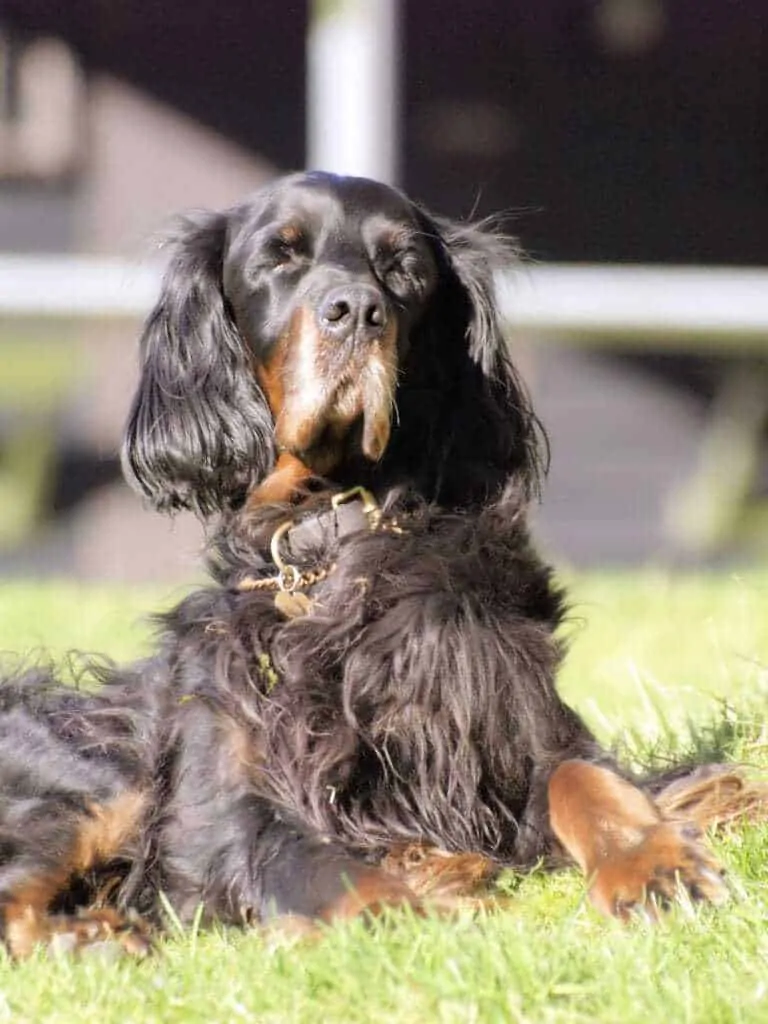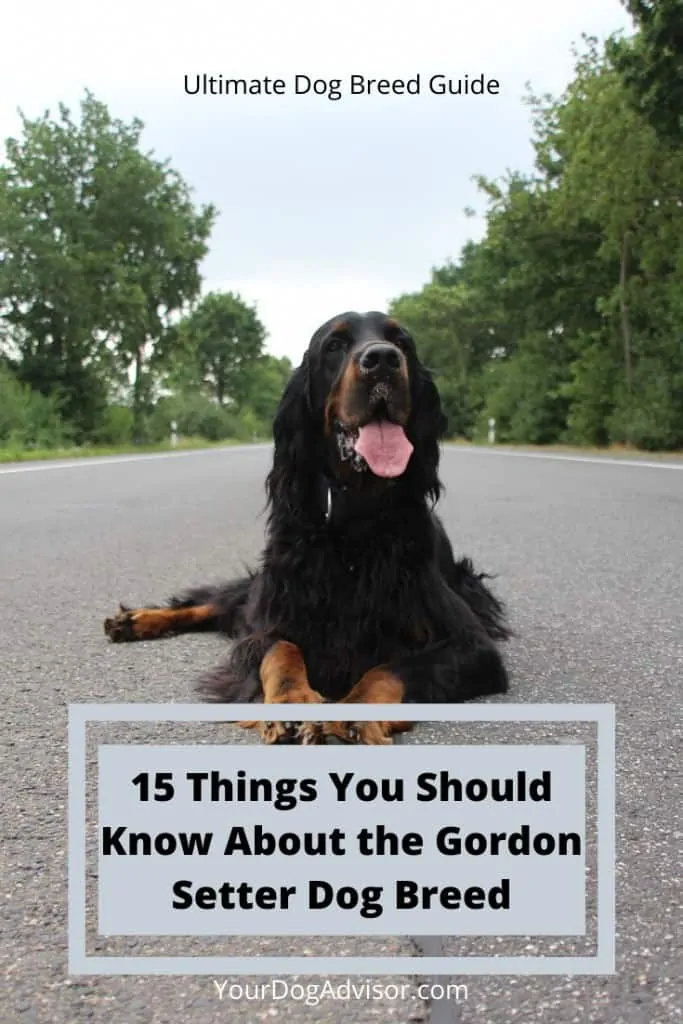The Gordon Setter has been around for a long time now, but the 4th Duke of Gordon brought it to people’s attention in the 1800s. These handsome and proud working dogs are also the largest of all the setters.
These dogs are acclaimed hunting dogs that specialized in scent work as well as tracking fallen birds. In this century, the Gordon Setter is a great family companion, and loves using its scent for games of fetch, incredible stamina, and occasional snacks.
Not only are these dogs handsome, but they are also intelligent and remain loyal to their owners and families. They enjoy being part of families and home environments, which is why they are one of the most famous family dogs.
However, in recent times, these dogs have been placed on the list of vulnerable native breeds by the Kennel Club; hence anyone looking to purchase or adopt a Gordon Setter has to register their interest with the Setter breeders. Here are 15 things you should know about the Gordon Setter dog breed:
The Gordon Setter tends to be livelier than hounds and this makes them great choices for active families
Contents
1. They Have Been Around Since 1620 But Only Gained Prominence 200 years later
The Gordon Setter originated from Scotland and England. They were bred specifically to hunt game birds, and they were very reliable. The residents were residents in Scotland from as early as 1620. However, their presence was only prominent 200 years later when the 4th Duke of Gordon brought them to his kennels.
The castle Gordon Setters were beautiful and had first-class hunting skills. Even though they are not the fastest of dogs, they could easily keep on from morning till evening steadily with good staying power. Their sense of scent is first class, and they rarely made false points. Whenever they stood, it was an indication that there were birds.
2. They Were Called Black-and-Tan Setters
Before these dogs were named after the fourth Duke of Gordon at Gordon Castle, they were known as black-and-tan setters with tan markings. It was the Duke who further developed the modern breed.
The early Gordons also came in black and white, red, and tricolor, but the Duke favored the black-and-tan colored dogs, and so that standard has prevailed over the years. When the Duke passed away in 1827, Duke of Richmond, his heir, carried on his Gordon Castle kennels.
126 Black-and-Tan setters were listed in England’s Kennel Club’s studbook between 1859-1874. The first official black and tan setter show happened in June of 1859, where a black and tan setter called Dandie won the price for Setters. The pedigree of this black and tan setter could be traced back to the Duke’s Gordon Castle kennels.
It wasn’t until 1924 that these dogs took up the Gordon Setter name. The first Gordons to be imported to America came from Gordon Castle’s kennels when George Blunt and Daniel Webster purchased Rachel and Rake in 1842. These two Gordon Setters were the foundation of this dog breed in the States.
The Gordon Setter then became recognized by the American Kennel Club in 1892. In 1924, the Gordon Setter Club of America, Inc, was formed and is still in existence today with a membership of more than 1,000 Gordons.
Among the 155 dog breeds and varieties recognized and registered by the AKC, the Gordon Setter ranks 88th.
The coat of the Gordon Setter is both beautiful and functional
3. They Are The Largest Setter Breeds
Inclusive of the Gordon Setter, there are three other setter breeds, including the Irish Red and White Setter, the Irish Setter, and the English Setter. However, the Gordon Setter is the largest and heaviest.
Males weigh between 25-36 kg (55-80 pounds) and the females 20-32 kg (45-70 pounds), the males are larger than the female counterparts, but both have beautiful traits.
Typical Height: 24 – 27 inches (61 – 69 cm) for Males, 23 – 26 inches (58 – 66 cm) for females
These dogs are famous for their intelligence and stamina, as well as for having an excellent memory. They become better hunting dogs with every passing year.
Gordons make good watchdogs and wary of strangers, but are often too sweet to be a good guard dogs
4. They Are Beautiful and Distinctive
These dogs have lovely glossy coats. Their muzzles are very long, and they have well-defined stops with nicely defined lips. Their noses are broad with wide-open nostrils and black.
They have dark brown eyes that boast a keen, intelligent, and kind expression in them. Their ears are thin and moderate in size and set low on their heads, lying flat on the heads. Their upper teeth neatly overlap with the bottom ones, and they have a strong jaw with a scissor bite.
They have arched necks that are lean and long, giving them a proud and noble look. Their shoulders are sloppy and long, and their front legs strong and straight. They are broad, well-muscled with strong, oval-shaped feet with arched hairy toes. They have feathery tails that are fine at the tip but thicker at the base.
They also have hair on their heads, ear tips, and the front of their legs. The rest of their boy has moderately long hair that lies flat and close.
When these dogs move, they do so at steady, free-moving actions propelled by a lot of drive from behind.
5. They are Intensely Loyal
These dogs are renowned for their intense loyalty. They are devoted to their families and owners. However, they are not very fond of strangers and are wary of people they don’t recognize. This quality makes them excellent watchdogs.
These dogs are quick to let you know when a stranger enters your property. Luckily, they also love to please their owners, which makes them easy to train.
6. They Need Consistent Training and Early Socialization
Even though these dogs can be easy to train, they require consistent and fair training. At some point, the Gordon Setter can reveal their dominant side. So, they won’t respond well to harsh training or correction methods.
They are sensitive dogs and will do well with positive reinforcement techniques that give him guidance and direction. They are well-suited for active, outdoorsy people because of the tremendous amount of stamina and courage.
If you want your Gordon to end up being a happy, curious, playful, and always willing to please you, you have to socialize him from an early age. When they’re puppies, the Gordon Setter tends to be more fearful and anxious when they are around 6-9 months.
Expose your Gordon to many different sights, people, experience, and sounds from when they are young. This will help the pup grow into a well-rounded Gordon Setter.
You can also enroll him in a puppy kindergarten class or taking him to busy parks, invite visitors regularly, or bring him along on leisurely strolls so that he gets to meet his neighbors and polish his social skills.
7. They Have a Very Playful Side
Even though these dogs are hunting and working dogs, they are social by nature. They have a very playful side and love to entertain as much as they love to be entertained as well.
When they’re in the mood, they can be a little mischievous, which allows them to pick up on what pleases their owners quickly. Their playful side, combined with their mischievousness, triggers their high prey drive. Hence, when they’re in the mood, you can find them chasing smaller animals like squirrels or cats in the household.
These dogs love to play and be active with their owners. So, If you want a companion for adventures, this is a great breed
8. They Get Major Separation Anxiety
The Gordon Setter is best suited for owners who will dedicate their time to these intelligent, energetic dogs. These dogs tend to form powerful ties with their owners and families, and so whenever they are left alone, they are not very happy.
These dogs are best suited for people who work from home, and those are in the household most of the time. They should not be left for long periods on their own because they will suffer from severe separation anxiety.
When anxious, Gordons become destructive and will do anything to entertain itself or relieve their stress, which includes excessive barking to try and get attention.
9. They are Excessive Barkers
Some Gordons love the sound of their voices a little bit too much. Hence when your Gordon Setter is still a puppy, be careful not to frighten them. These dogs are ultra-sensitive, and anything that triggers or scares them automatically results in barking.
Most Gordons tend to bark when they see strangers approaching them or when they notice something new or off in their surroundings.
It is also essential for Gordon Setter owners to keep noise levels down when their dog is in the household. Music and TVs shouldn’t play too loud to stress the puppy.
The Gordon Setter needs considerable daily exercise to remain happy and healthy
10. They Require High Maintenance Grooming
The Gordon Setter has glossy coats that require high maintenance grooming and daily brushing to keep the hairs from tangling. Gordon owners have to pay special attention to the dog’s featherings because they tend to grow long.
Whenever these dogs are out for walk-in wet weather, their coats need to be thoroughly dried to prevent any skin diseases or dogs from catching a chill. They shed all year round, especially during the spring and in the Autumn, hence during these seasons, frequent brushing is necessary to keep your dogs neat.
It is also essential to check their ears regularly and make sure to clean them when need be. Watch out for too much wax buildup because it could lead to a painful ear infection that could be hard to clear up if not detected early. When it comes to ear infections, prevention is easier and better than the cure.
11. They Need Tons of Physical Activity and Mental Stimulation
The Gordon Setter is smart and high energy. To keep them happy and healthy, they require a lot of physical activity and mental stimulation. They need a minimum of 1-2 hours of daily exercise to burn off their energy and keep them from getting bored.
Boredom makes dogs develop unwanted behavioral issues that could be destructive. You can try and fit in a short morning walk, but make sure to take him on a longer, more exciting walk in the afternoon.
They love being able to roam around the garden as much as possible because it helps them let off steam. However, these dogs are best suited for fenced yards because if the fence is not secure, they can easily escape and wind up getting into all sorts of trouble.
Even so, these dogs shouldn’t be given too much exercise because their bones and joints are still developing, and excess pressure could result in causing future problems later in their lives. That said, they shouldn’t be allowed to jump up and off the furniture or run up and down the stairs because these activities will still put pressure on their developing bones and joints.
And when they are not in the outdoors, these dogs still need activities that will keep stimulating their minds and engaging their intelligence.
The Gordon Setter is truly adaptable and all-purpose
12. They Grow Very Slowly, Hence Need a Feeding Schedule
Gordons grow quite slowly compared to other dog breeds, which means that they can’t be fed like every other dog. Gordon Setter breeders will more likely give you a feeding schedule that you should stick to when feeding the same Gordon to avoid any stomach upsets.
If you intend to change Gordon’s diet, you need to do so gradually and with supervision with your vet because these dogs are prone to developing digestive upsets. If you change your canine companion’s diet and start to notice their tummy is upset, you should put them back on their original diet and have your vet intervene before you put him on a new diet.
The older Gordon Setter is known to be finicky or fussy eats, but they should still be fed a high-quality diet. Mature dogs should be fed at least twice a day, in the morning, and even, and make sure their food meats all the necessary nutritional requirements.
Avoid giving Setters one large meal a day because they are prone to bloat. Instead, divide their meals and make sure they eat enough food and still be on a healthy weight range. Due to their proneness to bloat, avoid exercising your Gordon just before or after eating. Make sure to provide them with fresh, clean water at all times.
13. They Are Good With Kids
Gordon Setters are great around kids, and they get protective of children they have known from puppyhood. However, sometimes they can get overprotective, so supervision is advised between Gordon Setters and kids.
Gordon Setters will also get along with other dogs and other pets in the family if they were socialized from a young age and grew up in the same household.
Be sure to provide Gordon Setters with plenty of cool water and shade if you live somewhere extra warm, as they can be prone to overheating
14. They Suffer From a Few Hereditary Issues
Gordon Setters have an average life expectancy of 10-12 years when fed and taken care of properly. However, despite the 10-12 years typical life span, they suffer from a few hereditary health problems which you should ask your breeder about before purchasing a Gordon.
Some of these conditions include:
- Neuronal Ceroid Lipofuscinosis
- Hip Dysplasia
- Cutaneous Cysts
- Progressive Retinal Atrophy
- Otitis Externa
- Lipoma
- Mammary Lumps
- Arthritis
- Hypothyroidism
- Otitis Media
- Hypersensitivity Skin Disorder
- Urinary Incontinence
- Bloat/Gastric Torsion
15. Diane Sawyer and Ed McMahon Had Gordon Setters
Even though Gordon Setters are not common family pets, there are a few celebrities who had them. Diane Sawyer, ABC News anchor, had a Gordon Setter called George and Ed McMahon from “The Tonight Show” had a Gordon Setter called Juniper Berry.

Jen Jones is a professional dog trainer and behavior specialist with more than 25 years of experience. As the founder of ‘Your Dog Advisor’ and the ‘Canine Connection’ rehabilitation center, she applies a holistic, empathetic approach, aiming to address root causes rather than merely treating symptoms.
Well known for her intuitive and compassionate approach, Jen adopts scientifically-proven, reward-based methods, encouraging positive reinforcement over punishment. Jen specializes in obedience training, behavior modification, and puppy socialization. Her innovative methods, particularly in addressing anxiety and aggression issues, have been widely recognized. Jen has worked with many of the world’s leading dog behaviorists and in her free time volunteers with local animal shelters and rescue groups.







